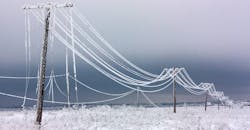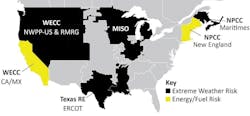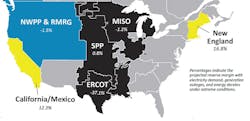Winter is Here, and Electric Reliability is Fading
Is the electric grid becoming more unreliable? One answer comes from the North American Electric Reliability Corporation (NERC) – a regulatory authority that works to reduce risks to the reliability and security of the national bulk power system (the electric grid.) Each year NERC publishes seasonal reliability assessments of the grid, and these assessments attempt to compare available grid resources to potential, future electric demand in a variety of scenarios.
NERC’s Winter Reliability Assessment for Winter 2021-2022 contains some ominous new information. The assessment warns of potentially significant, unreliable operations during extended “extreme” winter weather events, across many parts of the country in the weeks ahead. The new information now includes an estimate of how an extended severe winter event can impact various parts of the grid.
The reliability assessment for Winter 2020-2021, identifies areas that are susceptible to extreme weather events, but did not include the percentage change on the available reserve margins. We had no idea how serious the threat was. (Figure 1)All that changed last year with the brutal effects on ERCOT of winter storm Uri. That “polar vortex” event prompted additional analysis of the impact of extreme winter events and better estimates of available reserve margins.
Now, the latest reliability assessment (Figure 2) includes percentages to indicate the projected reserve margin, factoring in electricity demand, generation outages, and other impacts during extreme winter events.Note that many electric utilities strive to maintain a reserve margin of about 20% during normal operations.
Even more concerning is that several regional electric reliability bodies – MISO, SPP, ERCOT and NWPP and RMRG – may have to resort to “operating mitigations” that could result in actions which may include “load shed” (i.e., rolling blackouts.) Hopefully, things will not so bad that utilities must resort to that, but with reserve margins so low it is a distinct possibility of which metalcasters (especially those that rely on high volumes of electricity) should be aware.
Nowhere in the latest assessment could I find a definition of “extreme weather event”, but we have a pretty good idea from what happened in ERCOT last year.
We have had a very reliable electric grid for many years. It appears that reliability is quickly fading. It may be a good idea for every foundry to check its backup generators, especially for cold weather operations.
We also have helped foundries evaluate alternative sources of electric generation that they control. This can lower risk of outage, as well as provide dramatic cost savings.
Brian Reinke, president of TDI Consulting, is an energy-cost saving consultant. Contact him at [email protected].
About the Author
Brian Reinke
President
Brian Reinke, president of TDI Energy Solutions, is an energy-cost saving consultant. Contact him at 630-343-0971.


